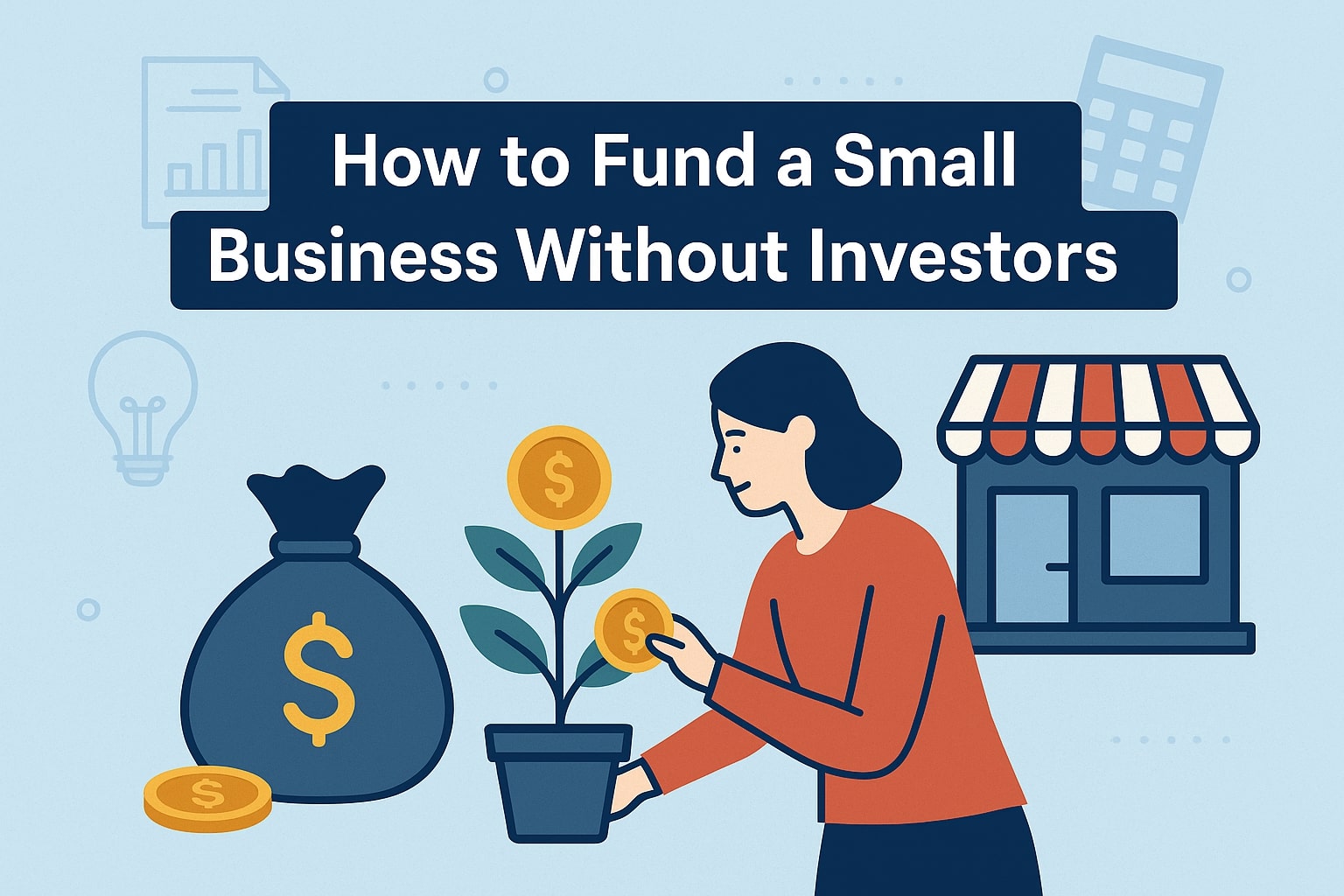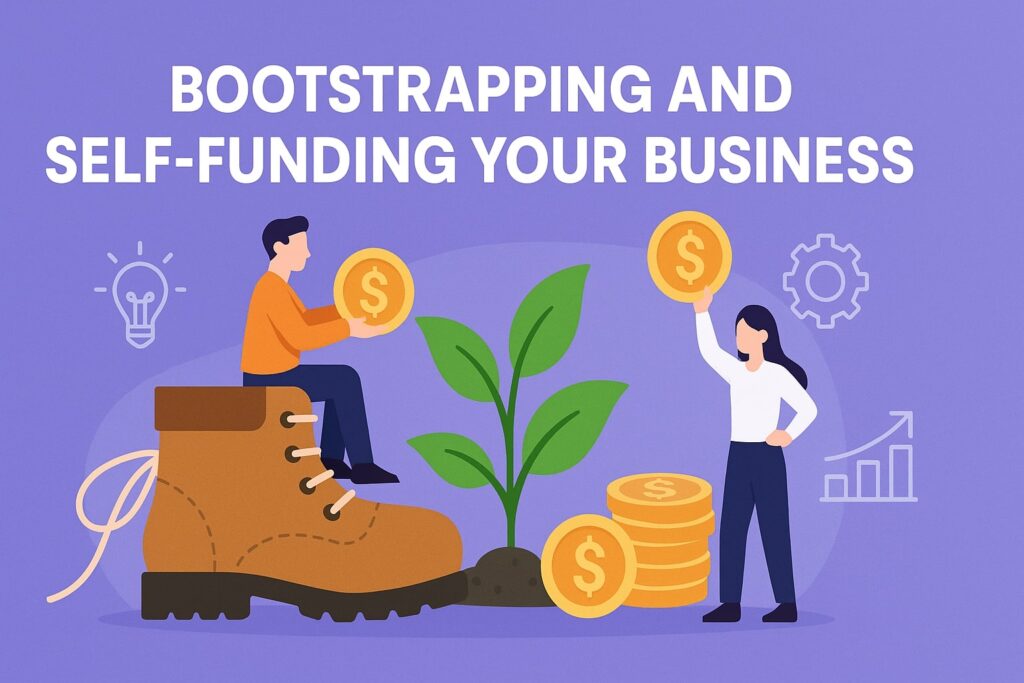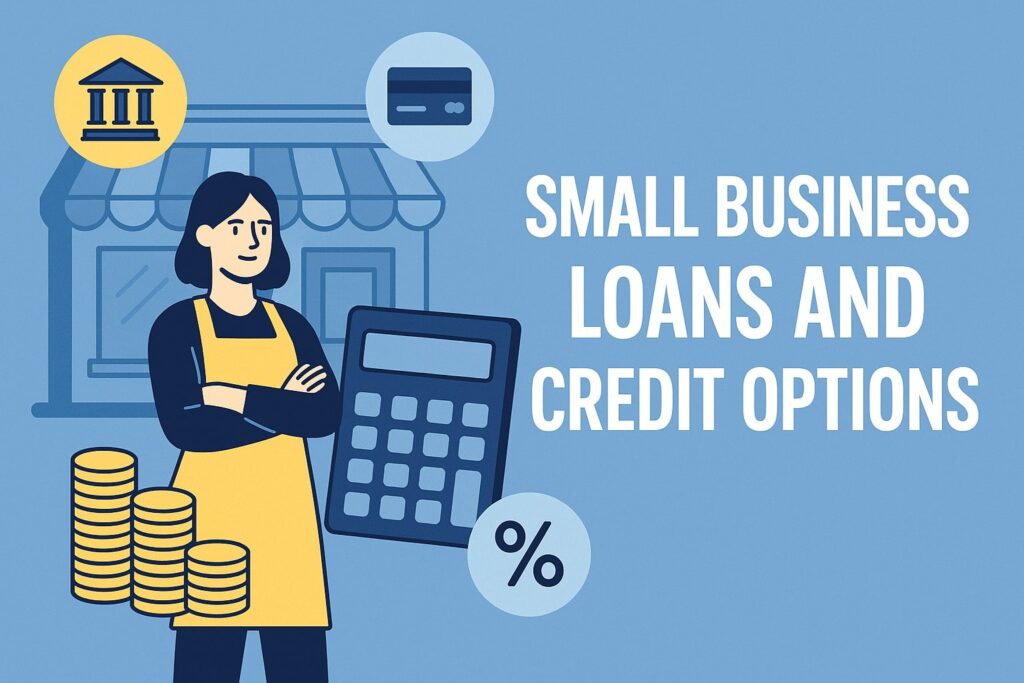
How to Fund a Small Business Without Investors
Bootstrapping a venture and finding non-equity funding can be critical for entrepreneurs who want to fund a small business without investors. In the US, most startups rely on internal resources: recent SBA data shows about 80% of new small businesses use personal savings to cover startup costs.
Unlike seeking venture capital or angel funding, funding without outside investors means using personal funds, loans, grants, or customer-based revenue.
USA.gov explicitly notes there are no federal grants for starting a business, so owners must “get money in different ways,” such as personal funds or loans. This guide surveys modern options – from bootstrapping and small business loans to crowdfunding and grants – to help you finance your business while retaining full ownership.
Bootstrapping and Self-Funding Your Business

A piggy bank symbolizes the practice of saving personal funds to self-finance a business. Bootstrapping means funding your business from your own resources rather than outside investors.
You can use personal savings, home equity, or loans from family and friends to cover startup costs and operating expenses. For example, you might reinvest early sales or use a personal 401(k) loan (with caution) to inject cash into your business.
Advantages include maintaining total control and avoiding interest payments to external parties. However, SBA experts warn that tapping retirement accounts early can incur hefty penalties and risk your future savings, so weigh these carefully.
A disciplined bootstrapping approach often also involves strict budgeting and reinvesting profits back into the business.
- Personal Savings: Using money from your own bank accounts is the most common path. The SBA reports that 80% of new businesses use personal savings for startup capital. This requires living frugally and planning expenses carefully.
- Family and Friends: Loans or gifts from friends and relatives can boost your funds without formal investors. Set clear terms to avoid misunderstandings, and treat these funds as you would any other loan.
- Personal Debt: Small entrepreneurs often use personal credit cards or personal loans to fund initial costs. NerdWallet notes that a business credit card can cover several thousand dollars of startup expenses. Just be aware that credit cards may carry high interest after promotional periods.
- Home Equity: If you own a home, a home equity line of credit (HELOC) can provide low-interest capital. This “borrowing against your home” carries risk if business cash flow falters, so proceed only if your revenue is predictable.
- Sweat Equity: Invest your own time and labor instead of cash. For example, doing your own marketing or repair work cuts costs. This isn’t funding in the strict sense, but it reduces cash needs.
Bootstrapping allows maximum control, but it usually means slower growth. As Investopedia notes, bootstrapping “allows business owners to maintain control” but also entails “increased financial risk due to limited resources”. In practice, many founders combine bootstrapping with other methods as the business grows.
Small Business Loans and Credit Options

If self-funding isn’t enough, traditional loans and lines of credit are key ways to finance a small business without selling equity. Small business loans let you retain ownership while borrowing capital that you repay with interest.
Before applying, prepare a solid business plan and realistic financial projections – this shows lenders how much you need and assures them you can pay it back.
The U.S. Small Business Administration (SBA) offers several loan programs to help startups that might otherwise be denied credit.
- SBA 7(a) Loans: This is the SBA’s main loan program. You can borrow up to $5 million for qualified needs (equipment, working capital, etc.). The SBA guarantees a portion of the loan, encouraging banks to lend to riskier small businesses.
Interest rates vary by loan size – for example, a loan of $50k or less can have an interest rate up to Base Rate + 6.5%, whereas larger loans (over $350k) are typically at Base + 3%.
The terms are usually 5–10 years for working capital or up to 25 years for fixed assets. Because you retain full equity, be prepared to repay on a regular schedule from your cash flow. - SBA Microloans: These are smaller loans (up to $50,000, averaging around $13,000) provided via nonprofit intermediaries. They are designed for startups and underserved businesses.
Uses include working capital, inventory, supplies, or equipment. Repayment terms can be up to 7 years, with typical interest rates in the 8–13% range. Eligibility is more flexible than a bank loan (often only a personal guarantee required), but amounts are limited. - Community Lenders and Credit Unions: Many local banks or credit unions offer startup loans or lines of credit, often with lower minimums than large banks.
Some nonprofit microlenders (such as Kiva or community development financial institutions) also offer favorable small loans with little or no interest. - Online Lenders: Nonbank online lenders can provide quick financing (often called term loans or merchant cash advances). They may lend to newer businesses (6–12 months old) but usually charge higher interest. Vet their fees carefully.
- Business Credit Cards and Lines of Credit: For short-term needs, business credit cards or a revolving line of credit (LOC) can be useful.
A credit card can cover initial expenses up to your credit limit – NerdWallet suggests this could be “a card with a limit of several thousand dollars” for prototyping or operating costs. Look for cards with 0% introductory APR offers to minimize interest.
A business LOC works like a credit card: you borrow up to a set limit, repay, and borrow again as needed. To qualify, you usually need good personal or business credit, and cards/lines should be used judiciously to avoid high debt. - SBA Lender Match: If you’re struggling to find a lender, SBA’s free Lender Match tool can connect you with banks and partners offering SBA-guaranteed loans. This can simplify finding terms suited to a small business.
Pro tip: Prepare a strong loan application. Lenders expect a clear business plan, income and expense statements, and forecasts for the next 3–5 years. These documents increase your chance of approval and better terms.
Crowdfunding and Customer Funding

Another way to fund a business without investors is to raise money from customers or the public via crowdfunding and pre-sales. With reward-based crowdfunding (e.g. on Kickstarter or Indiegogo), you pitch your product idea directly to future customers, who pledge small amounts in exchange for perks or early access.
Unlike venture capital, this gives no equity to backers; they essentially “pre-buy” your product. Crowdfunding can validate your idea and generate launch capital.
In fact, Kickstarter projects have attracted over $9 billion in pledges to date, showing how common this approach has become. (Keep in mind many Kickstarter campaigns are all-or-nothing: you must reach your goal to get any funding.)
Common crowdfunding models include:
- Rewards-based crowdfunding: Offer backers a gift (like a first-edition product or branded swag) instead of equity. This is suitable for product or media businesses.
- Donation-based crowdfunding: People donate without expecting anything in return – often used by social enterprises or nonprofits.
- Pre-sales: You can also run your own pre-sale campaign (e.g., taking deposits on your website) which acts like a crowdfunding campaign without platform fees.
Crowdfunding has trade-offs: it requires marketing effort to promote your campaign, and you’ll need to fulfill the promised rewards.
However, it doubles as market research. Moreover, smaller-scale platforms (or social media campaigns) can gather community support for service-based or local businesses.
Additional Note: There is also equity crowdfunding, where many small investors each buy a share of your company (through platforms like Wefunder or Republic). This technically involves investors, so it lies outside “without investors.” We focus here on non-equity funding.
Grants, Contests, and Non-Dilutive Funding

While rare for typical startups, certain grants and competitions can provide non-dilutive funding (money you don’t have to repay or give up equity for). These are usually highly targeted or competitive:
- Federal Programs (SBIR/STTR): The U.S. government offers research and development grants through the SBIR and STTR programs. These target innovative tech and science businesses.
Funding can be substantial (often $150,000+ per award) but requires a qualified R&D project and affiliation with a research institution (for STTR). If your business develops new technology, explore SBIR grants via SBIR.gov. - State and Local Grants: Some states, counties, or cities provide small grants or low-interest loans to promote local entrepreneurship or specific industries (e.g. green energy, technology, food services).
For example, economic development departments sometimes list grant opportunities. Grants like the Minnesota Emerging Entrepreneur Loan Program (through intermediaries) or city grants for ADA accessibility exist. Check your local Small Business Development Center or state economic website. - Business Plan Competitions and Incubators: Universities, nonprofits, and business organizations often run pitch contests where winners receive cash prizes or in-kind support (office space, legal help, etc.).
Even though prize amounts are modest, they can cover initial costs. Programs like the SBA’s Growth Accelerator Fund Competition award cash to accelerators (not directly to your business), but local accelerator programs may offer grants. - Corporation or Foundation Grants: Large companies sometimes run small-business grant contests (e.g. FedEx Small Business Grant, Visa Everywhere Initiative) or community development grants.
These are typically annual competitions with specific criteria. They provide free money, but competition is stiff. - Tax Credits and Hiring Subsidies: These aren’t direct funding, but programs like the Work Opportunity Tax Credit (WOTC) or state tax credits effectively reduce costs by giving you tax breaks for hiring certain employees.
Similarly, some training grants reimburse you for employee training. These indirectly free up capital.
Caution: Grant applications can be time-consuming and complex. As the U.S. Chamber warns, “acceptance of free money from the government comes with a fair amount of paperwork” and reporting obligations. Always verify eligibility before investing effort.
Improving Cash Flow and Business Credit
Even without investors, your cash flow management and creditworthiness play a huge role in funding viability:
- Build Business Credit: Open a business bank account and apply for a business credit card or small vendor accounts. Pay bills on time to build a credit history. A strong credit profile will make banks or suppliers more willing to extend loans or better terms.
- Separate Finances: Keep personal and business finances separate. This simplifies taxes and demonstrates professionalism to lenders.
- Reinvest Profits: As your business generates revenue, reinvest excess profits into growth (inventory, marketing, equipment). Rolling profits back into the company is the purest form of self-funding for later expansion.
- Negotiate Vendor Terms: Ask suppliers for extended payment terms or partial prepayment options. For example, an equipment vendor might let you pay half upfront and half in 30 days. This effectively acts like a short-term loan.
- Consider Barter or Trade: In some cases, you can trade your services for needed resources (e.g., web design in exchange for legal help). This conserves cash though it’s not cash funding per se.
By demonstrating good credit and control of cash flow, you make it easier to secure bank loans or lines of credit down the road, even without investor funding.
Other Creative Funding Strategies
While less common, here are a few more tactics to consider:
- Customer Contracts or Retainers: If you offer services, you could ask key clients for a deposit or retainer to fund early operations.
For example, a marketing agency might ask new clients to prepay a portion of fees. This is essentially using future sales to fund current costs. - Invoice Factoring/Financing: If you have issued invoices, you can sell them to a factoring company for immediate cash (typically receiving 70–90% of the invoice value).
This provides quick capital at a fee (factoring charges around 1–5% of invoice value). It’s a way to fund without equity, though costly. - Royalty Financing: Sometimes a financier will give you funds in exchange for a fixed percentage of future revenues (royalty). The cost can be high, but you avoid equity. This is a niche option usually for later-stage companies.
- Crowdsourced Loans (Peer-to-Peer Lending): Platforms like Funding Circle or LendingClub let small businesses borrow from individual lenders.
These loans are still “loans” you repay, but you raise them from many people rather than a single bank. They charge interest, but it’s an alternative to bank loans. (Though peer lenders technically are investors, they expect repayment plus interest, not equity.) - Licensing or Wholesale: If your business can license a technology or product, you might get upfront license fees. Or wholesale bulk orders from distributors can provide immediate revenue (sometimes on partial upfront payment).
These strategies illustrate that with creativity and good planning, a small business can often find funding without surrendering equity.
Table: Comparison of Non-Investor Funding Methods
| Funding Source | What It Is | Pros | Cons |
|---|---|---|---|
| Personal Savings | Money from your own accounts | Full control; no interest payments | High personal risk; may be limited amount |
| Family/Friends Loans | Borrowing from personal network | Flexible terms; fast funding | Strained relationships if unpaid; no credit impact |
| Bank or SBA Loans | Loans from banks or SBA (7(a), microloans) | Lower rates (esp. SBA); large sums possible; no equity loss | Requires repayment; collateral or guarantees; lengthy app |
| SBA Microloans | SBA-backed small loans (≤$50K) | Easier qualification; includes training; modest sum | Limited amount; higher interest (8–13%) |
| Business Credit Cards/LOC | Revolving credit line for business | Quick access; some have 0% APR intro; builds credit | High interest if carried; small credit limit initially |
| Crowdfunding (Rewards) | Pre-selling products or perks to supporters | No equity; market test; large reach (e.g. Kickstarter) | Time/marketing intensive; must deliver on promises |
| Donations/Grants | Free money from gov’t, foundations, contests | No repayment; no equity; can be sizeable | Very competitive; specific eligibility; heavy paperwork |
| Vendor/Supplier Credit | Delayed payments or trade credit from suppliers | Improves cash flow; sometimes interest-free | May limit vendor options; suppliers expect timely payment |
| Invoice Factoring | Sell accounts receivable for cash | Immediate funds; no new debt | Fees 1–5%; reduces profit; not suitable for startups without invoices |
FAQs
Q: Can I really start a small business without any outside investment?
A: Yes. The vast majority of small businesses in the U.S. begin with owner’s capital and loans, not VC funding. By combining personal savings, loans (bank or SBA-guaranteed), and creative cash-flow strategies, you can launch a business while retaining 100% ownership. Careful planning and frugality are key, since you won’t have a big check from an investor.
Q: What is the best way to fund a business without giving up equity?
A: It depends on your needs, but bootstrapping (using your own money and revenues) is fundamental. You can supplement this with traditional loans (like SBA 7(a) or microloans), or credit (business cards or lines).
Crowdfunding or pre-sales can raise initial capital for product-based businesses. Focus on self-funding first, then use debt financing if more capital is needed, since loans don’t give away equity.
Q: How do SBA loans help fund a business without investors?
A: SBA loans are government-backed loans you apply for through banks. Unlike equity, SBA loans are debt you repay. For example, an SBA 7(a) loan can offer up to $5 million for eligible businesses.
Because the SBA guarantees a portion of the loan, banks are more willing to lend even to startups. You keep all your ownership, paying back principal plus interest (rates might be base plus a few percent).
Q: What is an SBA microloan and who can get one?
A: An SBA microloan is a small business loan up to $50,000 offered through nonprofit lenders. These are designed for startups and businesses that lack access to traditional credit. The average SBA microloan is around $13,000.
Any for-profit small business can apply via an SBA-approved intermediary, which handles underwriting. Microloans often have more flexible criteria than bank loans, though they come with shorter repayment terms (up to 7 years) and interest (roughly 8–13%).
Q: Is crowdfunding really a funding method if I don’t give equity?
A: Yes – crowdfunding can provide capital without selling shares. In reward-based crowdfunding, backers contribute funds expecting a product, service, or perk in return, not ownership.
For many entrepreneurs, it’s like securing small deposits from future customers. Because the backers aren’t getting a stake in your company, crowdfunding fits the “no-investor” model. Just remember it requires strong marketing and reliable delivery on promises.
Q: Are there grants available for regular businesses?
A: Generally, no large federal grants exist for typical startups. Most grants are for specific purposes (like R&D through SBIR/STTR) or targeted groups.
Check local government and nonprofit programs for small grants. Keep in mind government and foundation grants usually have strict criteria and reporting requirements. For most businesses, it’s safer to assume you’ll self-fund or take loans rather than rely on grants.
Q: What about business credit cards – can they fund a business?
A: Business credit cards can fund part of your startup costs, especially if amounts are modest. As NerdWallet points out, a card with a credit limit of a few thousand dollars might cover prototyping or early expenses.
Look for cards with intro 0% APR to minimize interest. However, treat cards as short-term financing: pay balances in full during any 0% period to avoid high interest charges. For bigger needs, a bank or SBA loan is usually necessary.
Conclusion
Funding a small business without investors is entirely possible, especially for businesses that don’t need millions upfront. The key is to explore all non-investor financing options: start with bootstrapping – using your own savings and sweat equity – then supplement with loans, lines of credit, and creative revenue-based funding.
The SBA and other organizations offer many loan programs and resources (like SBA loans and microloans) that preserve ownership. Crowdfunding and grants can also add capital without equity, although they require effort to secure.
Ultimately, careful financial planning, a strong business plan, and disciplined cash management will make it feasible to grow your business on your own terms. By combining these strategies, you can fund your small business without investors, maintain control, and still achieve growth.